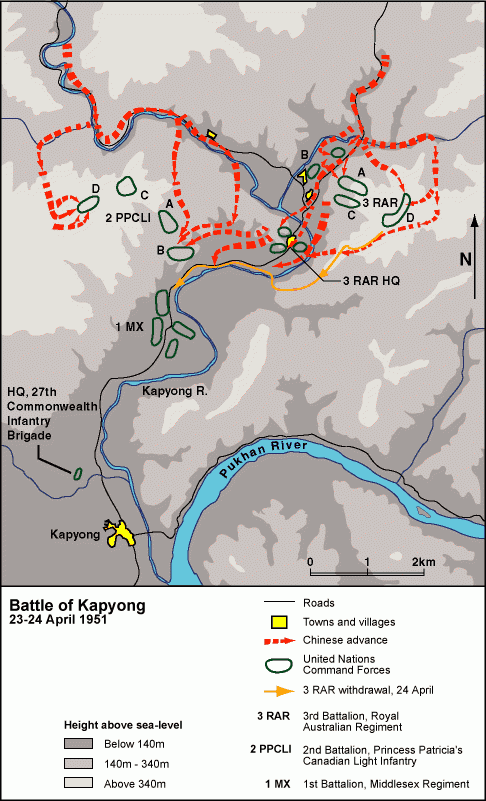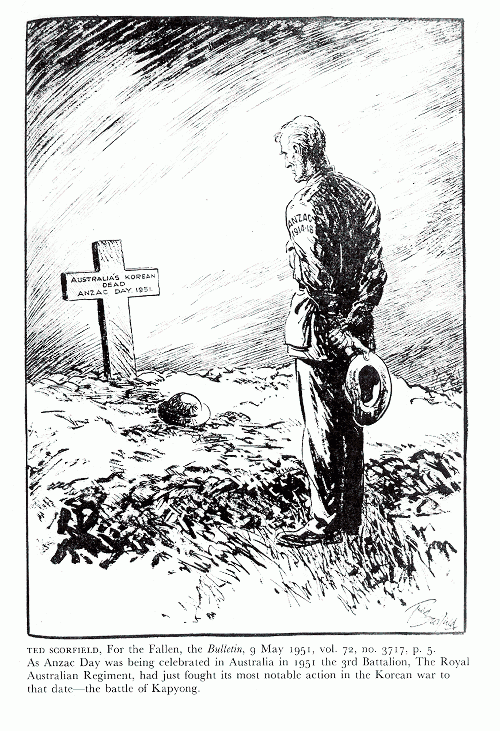Out in the Cold: Australia's involvement in the Korean War - Kapyong
- Home
- Timeline
- Origins
- Australians in Korea
- Australian Operations
- Weapons of War
- Faces of War
- Armistice and Aftermath
- Glossary
Kapyong - 23-24 April 1951
“At last I felt like an Anzac, and I imagine there were 600 others like me.”
Captain Reg Saunders, Officer Commanding, C Company, 3 RAR
Kapyong came to be the most significant and important battle for Australian troops in Korea.
In April 1951 the Chinese launched their spring offensive with the aim of retaking the city of Seoul. They quickly overran South Korean forces defending one of the major approach routes, the valley of the Kapyong River. Thirty kilometres further south, the 27th British Commonwealth Brigade hastily occupied defensive positions in an attempt to halt the Chinese advance.
On 23 April, the 3rd Battalion, Royal Australian Regiment (3 RAR), under the command of Lieutenant Colonel Bruce Ferguson, and the 2nd Battalion, Princess Patricia's Canadian Light Infantry, occupied prominent hills on either side of the seven-kilometre-wide valley, where a small tributary joined the Kapyong River. Also forward were headquarters units, tanks and artillery. The 1st Battalion, Middlesex Regiment, were to the rear.
Early in the evening, retreating South Koreans streamed past the Commonwealth position, with Chinese forces closely intermingled. Soon afterwards a platoon of American tanks supporting 3 RAR was overrun. The Kapyong valley was too large an area to defend with the forces available, and the brigade was spread very thinly.
Throughout the night the Chinese repeatedly pressed the Australian positions, attacking in waves over their own dead and wounded.
At dawn, A Company, under the command of Major Bernard "Ben" O'Dowd, found that the Chinese had infiltrated its position, but a counter-attack was able to eject them. Meanwhile B Company, which had spent the night on a hill near the riiver, discovered Chinese occupying some old bunkers on a small knoll. Hand-to-hand fighting ensued with grenades and bayonets. C Company, under the command of Captain Reg Saunders, was in position to reinforce both A and B Companies.
"Major O'Dowd then directed the radio operator to contact anyone. The American 1st Marine Division answered but their operator refused to believe who our operator was speaking for. Major O'Dowd took the phone and demanded to speak to the commanding officer. The general in charge of the [Marine] division came on the phone and told O'Dowd we didn't exist as we had been wiped out the night before. Major O'Dowd said, 'I've got news for you, we are still here and we are staying here.'"
Private Patrick Knowles, 3 RAR, on the morning of 24 April 1951
Fighting continued throughout the day with the Australians holding their positions, and the Chinese also engaging D Company. But late on 24 April, with their position now untenable, the Australians were forced into a fighting withdrawal down a ridge to the valley, where they rejoined the brigade. Their withdrawal was supported by New Zealand artillery from the 16th Field Regiment. Having found the Canadian position unassailable, the Chinese made no further attacks. By the afternoon of 25 April the road through to the Canadians had been cleared of Chinese and 2 PPCLI was relieved by US Army units. On Anzac Day 1951, the Australians rested after a long fight.
Thirty-two Australians were killed and 53 were wounded for their part in stalling the Chinese advance and preventing Seoul from falling into enemy hands.
Lieutenant Colonel Bruce Ferguson was awarded the Distinguished Service Order for his skilful leadership, and the Australian and Canadian battalions both received United States Presidential Distinguished Unit Citations for their part in the battle.

Kapyong diorama, sculpted by Lu Skacej and Dean Colls for the Conflicts: 1945 to Today galleries
Ivor Hele, Landscape at Kapyong Valley in Korea during the Battle of Kapyong, 23-25 April
A view of the Kapyong valley, seen from the defensive positions held by 3 RAR during the battle of Kapyong.
A view of the Kapyong valley, showing the positions of C Company in the middle distance, D Company in the upper left, and A Company in the left foreground.

Ted Scorfield, "For the Fallen", The Bulletin, 9 May 1951.
Sergeant S.K.J. "Len" Lenoy, who was killed in action at Kapyong while commanding a machine-gun section
with A Company.
General J. Van Fleet, General Officer Commanding, US Eighth Army, inspects members of the 3 RAR while bestowing the Presidential citation in recognition of the unit's action at Kapyong.
Australian Battles
- 3rd Battalion, Royal Australian Regiment
September 1950 - February 1954 - Yongju/The Apple Orchard
October 22, 1950 - Kujin/ Broken Bridge
October 25-26, 1950 - Chongju
October 29, 1950 - Pakchon
November 5, 1950 - Kapyong
April 23-24, 1951 - Maryang San/Operation Commando
October 2-8, 1951 - 1st Battalion, Royal Australian Regiment
March 1952 - Sept 1953 - Operation Fauna
Dec 10-11, 1952 - 2nd Battalion, Royal Australian Regiment
March 1953 - Sept 1954 - Samichon/The Hook
July 24-26, 1953 - The Royal Australian Navy
- Operation Han
July-Sept, 1952





